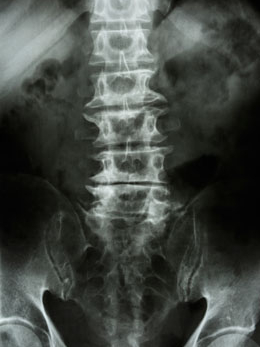Bulging disc surgery is performed on patients if the protruded disc affects the nerve roots or the spine canal. This article provides information regarding the same.

A bulging disc is a painful medical problem of the neck or back portion, manifested when an intervertebral disc bulges out abnormally. The disc serves as a cushion to the individual vertebrae. It is composed of a gel-like substance (the nucleus pulposus) at the center and a tough, fibrous outer layer (the annulus fibrosus). The term "bulging disc" is used interchangeably with "herniated disc"; however there is a difference between the two. In a bulging disc, the outer layer of the disc is not ruptured like in herniated disc, and therefore the nucleus pulposus does not leak out of the disc. Only a small bubble protrudes into the spinal canal. The affected disc may exert pressure on the adjacent nerve roots or spinal canal, and thereby cause pain.
The treatment options include taking adequate rest and other self-care tips like applying cold (or warm) compresses, massaging, and other conservative methods such as exercises, medications, and physical therapy. Surgery is considered when the conservative treatment methods are ineffective or an affected disc becomes herniated (slipped).
In most of the cases, this condition occurs due to aging. Therefore, majority of the candidates for surgery are elderly patients. In case the back pain intensifies, or radiates to other parts of the body, the doctor may conduct imaging tests to diagnose the severity of this condition.
Options
For a candidate with severe pain, the doctor will determine the appropriate surgery type. Open discectomy, or simply discectomy, is the commonly conducted surgery for this condition. It involves removal of the disc material that presses on the nerve root or spine cord. A less invasive option is the percutaneous discectomy, in which a special tool (cannula) is used to remove the herniated disc material from the affected spine portion. Other alternatives of disc surgery are electrothermal disc decompression and endoscopic discectomy. Factors such as the severity of the problem and overall health of the patient are taken into account while determining the appropriate surgical method.
Procedure
Most probably, the doctor may perform open discectomy or microdiscectomy. Both the procedures require administration of general anesthesia. In discectomy, an incision is made in the affected area and the protruded disc material is removed. In some cases, the surgeon may first take out a section of the lamina (bone) to get easy access to the bulged disc. In microdiscectomy, a small cut is made in the back, and a special optical tool with additional equipment is inserted in the affected area. With reference to the magnified image, the surgeon is able to remove the disc material from the affected portion.
Recovery
After surgery, the patient should follow the doctor's recommendations (medication, massaging, dressing) for quick recovery. Overall, the success rate for disc surgery is highly impressive, and maximum candidates are able to perform their normal activities within the next 2-3 days. Nevertheless, one should take proper care to minimize the risk of recurrence of this condition.
The cost of surgery may vary according to the location, procedure type, and severity of the problem. On an average, it costs around USD 6,000. Any spine related problem should be addressed as soon as possible. This will help treat the condition with conservative therapeutic intervention, and thereby minimize the need of surgery.
Disclaimer:
This Buzzle article is for informative purposes only, and should not be used as a replacement for expert medical advice.


 A bulging disc is a painful medical problem of the neck or back portion, manifested when an intervertebral disc bulges out abnormally. The disc serves as a cushion to the individual vertebrae. It is composed of a gel-like substance (the nucleus pulposus) at the center and a tough, fibrous outer layer (the annulus fibrosus). The term "bulging disc" is used interchangeably with "herniated disc"; however there is a difference between the two. In a bulging disc, the outer layer of the disc is not ruptured like in herniated disc, and therefore the nucleus pulposus does not leak out of the disc. Only a small bubble protrudes into the spinal canal. The affected disc may exert pressure on the adjacent nerve roots or spinal canal, and thereby cause pain.
A bulging disc is a painful medical problem of the neck or back portion, manifested when an intervertebral disc bulges out abnormally. The disc serves as a cushion to the individual vertebrae. It is composed of a gel-like substance (the nucleus pulposus) at the center and a tough, fibrous outer layer (the annulus fibrosus). The term "bulging disc" is used interchangeably with "herniated disc"; however there is a difference between the two. In a bulging disc, the outer layer of the disc is not ruptured like in herniated disc, and therefore the nucleus pulposus does not leak out of the disc. Only a small bubble protrudes into the spinal canal. The affected disc may exert pressure on the adjacent nerve roots or spinal canal, and thereby cause pain.